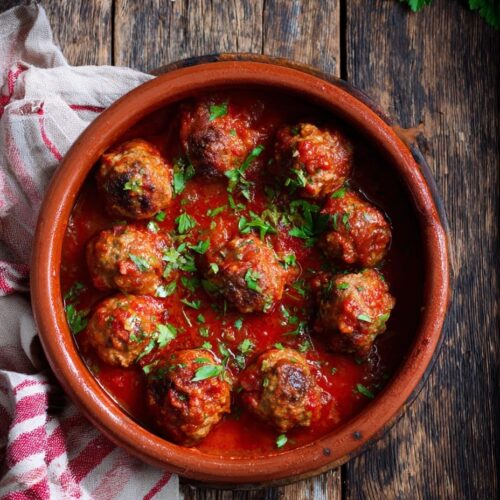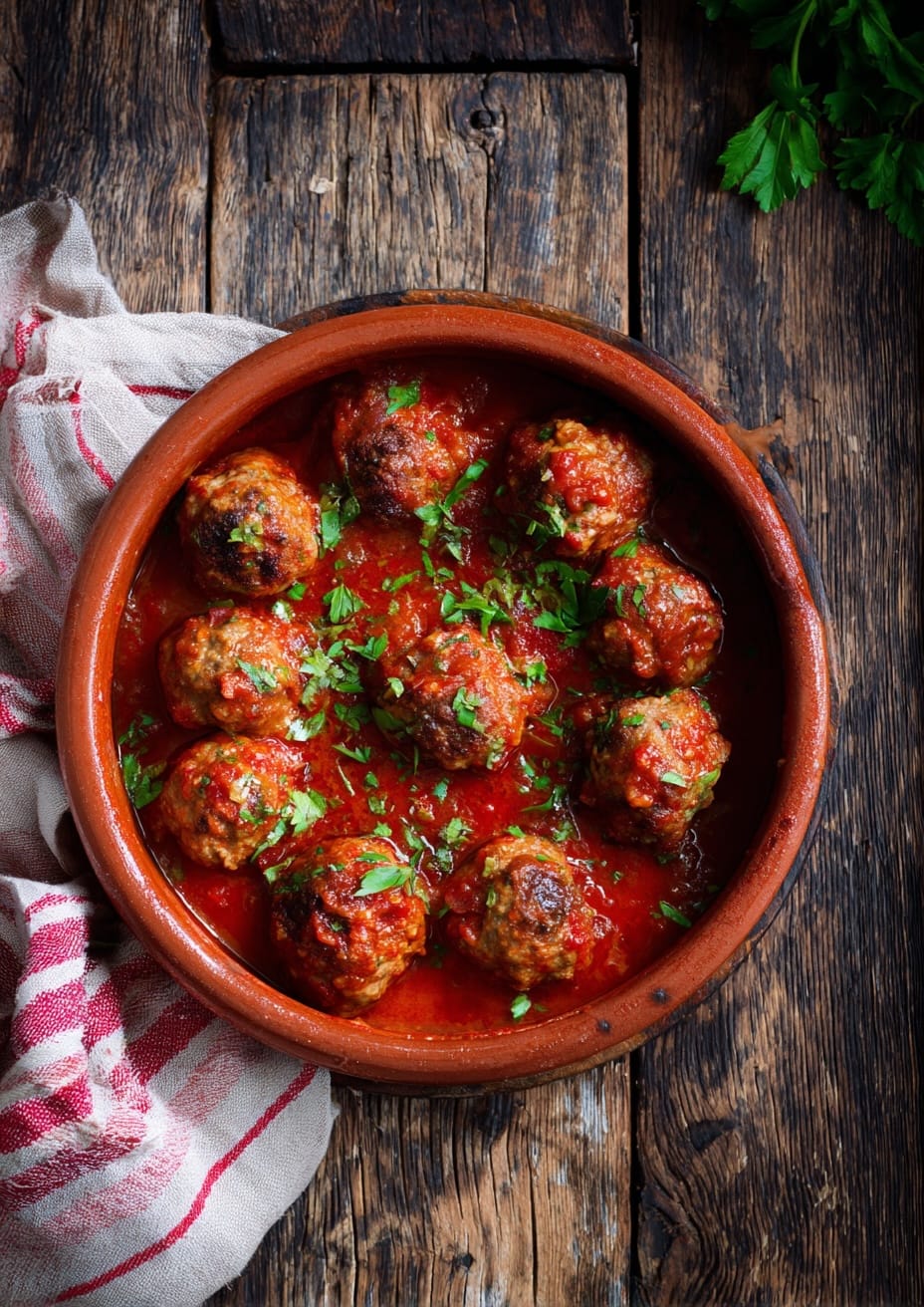A comforting plate of Spanish meatballs in rich tomato sauce
A homely Spanish favourite with a timeless feel
When I think of Spanish albondigas (meatballs) recipes, my mind always returns to albondigas in a rich tomato sauce. I remember the first time I ate them in a small Spanish tapas bar; the tomato sauce was silky, almost jammy, clinging lovingly to each tender ball of beef and pork. Since then, it’s become a dish I make often at home, whether on a damp weeknight or when friends gather round the table. This isn’t a complicated recipe, but it delivers warmth and a sense of comfort every single time.
Why this version is special to me
I’ve experimented with many different Spanish meatball recipes, but the one I keep coming back to is the classic. The combination of beef and pork keeps the meatballs juicy, while a touch of paprika and garlic infuses them with unmistakable Spanish character. Some people cook their albondigas directly in the sauce, but I prefer to brown them first for a deeper flavour. If you’re in the mood for a smokier variation, you could always try my Smoky Chorizo and Beef Spanish Meatballs, though I’ll admit the classic never fails.
The heart of Spanish family cooking
This dish is as versatile as it is delicious. It works equally well served as a tapa in small terracotta bowls or as a hearty supper alongside Saffron Rice with Spanish Herbs. I also like making a larger batch and freezing half, ready for a quick supper later in the month. Compared to spicier meatball recipes like my Spanish Lamb Meatballs with Mint and Paprika, this one is more mellow, making it perfect for families.
Why you should try this recipe now
Whether you’re new to Spanish meatball recipes or a seasoned cook, this dish is an excellent starting point. The flavours are straightforward but deeply satisfying. If you’re keen to explore more festive options, you could look at my Holiday Spanish Meatballs with Cranberry Glaze. But first, let’s master this classic albondigas in tomato sauce — the foundation of Spanish meatball cooking. For more inspiration across styles and occasions, I’ve created a full guide to Spanish Meatball Recipes.
Ingredients
- 300 g minced beef
- 300 g minced pork
- 1 small onion, finely chopped
- 3 cloves garlic, minced
- 50 g breadcrumbs
- 1 medium egg
- 2 tbsp milk
- 1 tsp smoked paprika
- ½ tsp ground cumin
- 2 tbsp fresh parsley, chopped
- 3 tbsp olive oil
- 400 g tinned chopped tomatoes
- 2 tbsp tomato purée
- 125 ml dry white wine
- 1 bay leaf
- Salt and black pepper to taste
Ingredient Notes
The blend of pork and beef is traditional, giving a balance of fat and lean meat. Pork adds softness, preventing the meatballs from becoming dry, while beef lends robust flavour. If you can, use meat with around 15–20% fat to keep the meatballs tender. Leaner meat can make them slightly crumbly.
Smoked paprika is non-negotiable here, adding depth and a whisper of smokiness to the sauce. Spanish paprika (pimentón) comes in dulce (sweet) and picante (hot). I usually go with dulce for balance, but if you like heat, swap half for picante. The wine adds acidity and fragrance, though you can replace it with chicken stock if you prefer not to cook with alcohol.
Instructions
Start by placing the beef, pork, onion, garlic, breadcrumbs, egg, milk, paprika, cumin, parsley, salt, and pepper in a large bowl. Mix gently with your hands until combined but don’t overwork, as this can make the meatballs tough. Roll into walnut-sized balls and set aside on a tray.
Heat two tablespoons of olive oil in a large frying pan over medium heat. Brown the meatballs in batches, turning them carefully so they colour evenly. Once browned, remove and set aside. Don’t worry if they’re not cooked through; they’ll finish in the sauce.
For the sauce, heat the remaining olive oil in the same pan. Add the bay leaf and let it sizzle briefly, then stir in the tomato purée and cook until it darkens slightly. Pour in the white wine, scraping up any caramelised bits from the bottom. Add the chopped tomatoes, season lightly, and simmer for 10 minutes.
Return the browned meatballs to the pan, spooning the sauce gently over them. Cover and simmer for 20 minutes until the meatballs are cooked through and the sauce thickened. Adjust seasoning to taste and serve with extra parsley sprinkled over the top.
Cooking Techniques and Recommendations
Browning the meatballs is worth the extra step. The caramelisation develops complex flavours and adds a slight crust, which stands up better in the sauce. If the pan looks dry while browning, add a touch more oil rather than lowering the heat. Meatballs that simmer too long without browning can fall apart more easily in the sauce.
The sauce benefits from slow simmering. If time allows, let it cook for an additional 15 minutes with the lid slightly ajar. This concentrates the flavours, and the tomato takes on a jam-like richness. Don’t skip scraping the bottom of the pan after deglazing with wine — that’s where the flavour sits.
What to Serve with This Recipe
These meatballs pair beautifully with Patatas Bravas with Spicy Sauce. The crisp potatoes and punchy sauce balance the richness of the tomato base. Saffron rice is another classic side, its fragrance lifting the dish into something special for a dinner party.
For a lighter option, I sometimes serve these with Spanish Roasted Vegetables with Rosemary. The herbs complement the meatball seasoning, and the roasted texture adds variety. In a tapas spread, they sit well next to garlic bread or chickpea salad, offering balance and colour.
Wine and Beer Pairings
A Tempranillo from Rioja makes a perfect partner, with enough acidity to cut through the sauce and enough depth to complement the meat. A lighter Garnacha also works well, with fruity notes that contrast beautifully with the smoky paprika.
If you prefer beer, a malty amber ale pairs nicely with the tomato richness. For something crisper, a Spanish lager like Estrella Damm refreshes the palate between bites and highlights the parsley and garlic in the meatballs.
Frequently asked questions about Spanish meatballs
Are Spanish albondigas the same as Italian meatballs?
Not quite. Spanish albondigas are smaller, seasoned with paprika and herbs, and simmered in a tomato-based sauce. Italian meatballs often include Parmesan or basil. For variety, you might enjoy my Spanish Meatballs with Sherry and Garlic, which shows another regional difference.
Can I make these Spanish meatballs ahead of time?
Yes. Prepare the meatballs, brown them, and refrigerate for up to 24 hours before simmering in sauce. This is also how I prep for my Quick Weeknight Spanish Turkey Meatballs.
What’s the best way to make Spanish meatballs gluten-free?
Swap the breadcrumbs for ground almonds or gluten-free crumbs. This method also works well with my Juicy Chicken and Manchego Spanish Meatballs.
How long do leftovers last in the fridge?
Cooked albondigas keep for 3–4 days when stored in an airtight container. For another hearty dinner, try pairing them with Warm Spanish Chickpea Salad.
What’s the origin of Spanish albondigas?
The dish has Moorish roots, with the name derived from Arabic. Over time, it adapted into Spanish kitchens with the use of paprika and wine. If you’re curious about more seasonal twists, check out my Holiday Spanish Meatballs with Cranberry Glaze.
Tips for Success with Spanish Meatball Recipes
When shaping the meatballs, lightly oil your hands to stop sticking and to keep the surface smooth. Smooth edges help them brown evenly and hold together during simmering. Overworking the mixture will tighten the texture, so keep the mixing gentle.
Simmer the sauce with patience. Spanish meatball recipes thrive on depth, and rushing the sauce leaves it tasting thin. A touch of extra cooking time rewards you with richness and depth.
Recipe Variations
For a spicier twist, add chopped chorizo into the meat mixture, echoing the flavours in my Smoky Chorizo and Beef Spanish Meatballs. Alternatively, you can add diced roasted peppers to the sauce for sweetness and colour.
If you want a lighter option, try swapping half the beef for chicken mince. The meatballs will be leaner but still flavourful, especially if you add manchego cheese as in my Juicy Chicken and Manchego Spanish Meatballs.
Storage and Reheating for Spanish Meatball Recipes
These meatballs store well in the fridge for 3–4 days in a sealed container. To reheat, warm gently in a covered pan with a splash of water to loosen the sauce. Avoid microwaving too aggressively as the meatballs can toughen.
They also freeze well for up to 3 months. Defrost overnight in the fridge and reheat in a saucepan until piping hot throughout.

Classic Spanish Albondigas in Tomato Sauce
Ingredients
- 300 g Minced beef
- 300 g Minced pork
- 1 Onion small, finely chopped
- 3 cloves Garlic minced
- 50 g Breadcrumbs
- 1 Egg medium
- 2 tbsp milk full fat
- 1 tsp Smoked paprika
- ½ tsp Ground cumin
- 2 tbsp Fresh Parsley chopped
- 3 tbsp Olive oil extra virgin
- 400 g Tomatoes tinned, chopped
- 2 tbsp Tomato Puree
- 125 ml White wine dry
- 1 Bay Leave
- Salt to taste
- Black pepper freshly ground, to taste
Instructions
- Start by placing the beef, pork, onion, garlic, breadcrumbs, egg, milk, paprika, cumin, parsley, salt, and pepper in a large bowl. Mix gently with your hands until combined but don’t overwork, as this can make the meatballs tough. Roll into walnut-sized balls and set aside on a tray.
- Heat two tablespoons of olive oil in a large frying pan over medium heat. Brown the meatballs in batches, turning them carefully so they colour evenly. Once browned, remove and set aside. Don’t worry if they’re not cooked through; they’ll finish in the sauce.
- For the sauce, heat the remaining olive oil in the same pan. Add the bay leaf and let it sizzle briefly, then stir in the tomato purée and cook until it darkens slightly. Pour in the white wine, scraping up any caramelised bits from the bottom. Add the chopped tomatoes, season lightly, and simmer for 10 minutes.
- Return the browned meatballs to the pan, spooning the sauce gently over them. Cover and simmer for 20 minutes until the meatballs are cooked through and the sauce thickened. Adjust seasoning to taste and serve with extra parsley sprinkled over the top.

